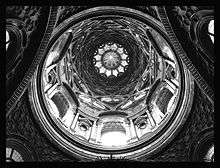Turin Cathedral
| Turin Cathedral Italian: Duomo di Torino | |
|---|---|
|
Cathedral of Saint John the Baptist Italian: Cattedrale di San Giovanni Battista Latin: Ecclesia Sancti Johannis Baptista | |
 | |
| 45°04′24″N 7°41′08″E / 45.07332°N 7.685435°ECoordinates: 45°04′24″N 7°41′08″E / 45.07332°N 7.685435°E | |
| Location | Turin |
| Country | Italy |
| Denomination | Roman Catholic |
| Website |
www |
| History | |
| Consecrated | 1505 |
| Relics held | Shroud of Turin |
| Architecture | |
| Status | Cathedral |
| Functional status | Active |
| Architect(s) | Amedeo de Francisco di Settignano (it) |
| Style | Renaissance and Baroque |
| Years built |
1468-1470 (bell tower)[1] 1491-1498 |
| Specifications | |
| Number of towers | 1 |
| Tower height | 130 feet (40 m)[2] |
| Administration | |
| Archdiocese | Turin |
| Province | Turin |
| Clergy | |
| Archbishop | Cesare Nosiglia |
Turin Cathedral (Italian: Duomo di Torino; Cattedrale di San Giovanni Battista ) is a Roman Catholic cathedral in Turin, northern Italy. Dedicated to Saint John the Baptist (Italian: San Giovanni Battista), it is the seat of the Archbishops of Turin.
It was built during 1491–98 and is adjacent to an earlier campanile built in 1470. Designed by Guarino Guarini, the Chapel of the Holy Shroud (the current resting place of the Shroud of Turin) was added to the structure in 1668–94.
History
Lombard church
The church lies in the place where the theatre of the ancient Roman city was located. The original Christian sacred house included three churches, dedicated to the Holy Saviour, Saint Mary of Dompno (Santa Maria de Dompno) and, the main of three, St. John the Baptist. According to some sources, the latter's consecration was carried on by Agilulf, the Lombard King of northern Italy from 591 to 613.[3] Here, in 662, Garibald, Duke of Turin (it) was assassinated in the church by a follower of Godepert, whose murder Garibald is believed to have had a part in.
The three churches were demolished between 1490 and 1492. The new cathedral, again entitled to St. John the Baptist, was begun in 1491 under design of Amedeo de Francisco di Settignano, also known as Meo del Caprino, who finished it in seven years. The bell tower, however, remained the one erected in 1469, which is still visible today. Filippo Juvarra brought some modifications in the 17th century. Pope Leo X officially confirmed it as metropolitan see in 1515.
A project for an enlargement of the cathedral, in order to create a more luxurious seat for the Shroud, was launched in 1649, when Bernardino Quadri arrived in Turin from Rome at the court of Duke Charles Emmanuel II of Savoy. Quadri's design was based on a previous project by Carlo di Castellamonte, with an oval chapel behind the choir. In 1667 Guarino Guarini was called in to complete the project. The dome, whose works dragged for 28 years, was completed in 1694 under the direction of Marie Jeanne of Savoy, Charles Emmanuel II's widow.
The cathedral is the burial place of Blessed Pier Giorgio Frassati (1901–1925), Turin native, avid athlete, and benefactor of the poor, called the "saint for youth of the Third Millennium." He was beatified by John Paul II in 1990.
While the chapel of the Holy Shroud behind the cathedral was undergoing renovation during 2009, the Shroud was kept in a small chapel within the cathedral.
Notable people
- Funerals and burials
- Giovanni "Gianni" Agnelli, member of the Agnelli family who own Fiat[5]
- Andrea Pininfarina[6]
- Luciana Frassati Gawronska
- Blessed Pier Giorgio Frassati
As Turin was the capital city of the Kingdom of Savoy, the cathedral is one of two in which members of the Royal Family (including the cadet branches) are buried in, the other being the Basilica of Superga in the outskirts of the city. Several royal consorts and princesses are buried here.
Gallery
- The central nave. Behind the altar, the panel painting that replicates the original viewing on the Cappella della Sacra Sindone (Chapel of the Holy Shroud) with the Altar of Bertola. Both works have been seriously damaged during the fire of 1997 and are still under restoration
 Inside of the Guarini Chapel
Inside of the Guarini Chapel A churchgoer prays in front of the Holy Shroud
A churchgoer prays in front of the Holy Shroud The Holy Shroud is visible only during the Ostensioni
The Holy Shroud is visible only during the Ostensioni Cappella dei Santi Crispino e Crispiniano. Polyptych of the Shoemakers Company (1498-1504), Giovanni Martino Spanzotti and Defendente Ferrari
Cappella dei Santi Crispino e Crispiniano. Polyptych of the Shoemakers Company (1498-1504), Giovanni Martino Spanzotti and Defendente Ferrari Giovanna d'Orlier de la Balme tomb monument. At the top is missing the emblem of the family that was destroyed by French troops during the Napoleonic occupation
Giovanna d'Orlier de la Balme tomb monument. At the top is missing the emblem of the family that was destroyed by French troops during the Napoleonic occupation- Vegezzi-Bossi organ
 Torre campanaria (bell tower)
Torre campanaria (bell tower)
References
| Wikimedia Commons has media related to Duomo (Turin). |
- ↑ "Il campanile (The bell tower)". duomoditorino.it.
- ↑ "Bell tower of the Cathedral". Roman Catholic Archdiocese of Turin.
- ↑ Giuseppe Colli. Storia di Torino, il Punto, Turin, 2002
- ↑ Anderson, Emily, ed. (1997). The Letters of Mozart and his Family (3rd ed.). Macmillan Reference Ltd. p. 151.
- ↑ "Italy bids farewell to Agnelli". BBC. 26 January 2003.
- ↑ "Ai funerali di Pininfarina: la commozione di Torino". Il Giornale (in Italian). 11 August 2008.
